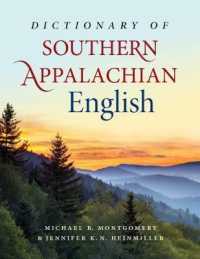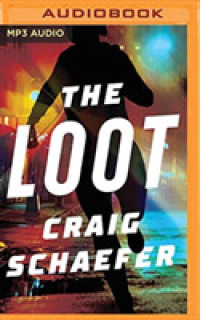Full Description
Inclusive Education in the Early Years is written for pre-service teachers to assist in the development of their skills and knowledge about inclusion, disability and inclusive education, within the context of their role as early childhood educators. The text covers critical aspects of teacher development in relation to fostering inclusive language and communication, enabling social interactions (including play) and supporting positive behaviour development. The state of play and implications of the current Australian context for early childhood education is explored, including consideration of the Early Years Learning Framework of Australia and the current legislative and policy contexts.
Contents
SECTION 1: UNDERSTANDING INCLUSION IN THE EARLY YEARS1. Better Together: Inclusive Education in the Early YearsKathy CologonIntroductionBarriers to inclusionThe journey towards inclusionWhy is inclusion important?Inclusive early years professionalsBecoming inclusiveConclusion2. Ableism, Disablism and the Early YearsKathy Cologon & Carol ThomasIntroductionMedical and social model understandings of disabilityDeconstructing disabilityTowards a social relational understanding of disabilityAbleismChildren's experiences of disabilityConclusion3. More than a Label? The Power of Language Kathy CologonIntroductionConclusion4. Legislation and Policy in Early Years InclusionAnne PetriwskyjIntroductionNational universal legislation and policySector-specific national legislation and policyNational policy for target groupsTargeted state-based policyConclusionSECTION 2: DIVERSITY AND INCLUSION IN THE EARLY YEARS5. 'Not just being Accepted, but Embraced': Family Perspectives on InclusionKathy CologonIntroductionResisting stigma and disestablishing ableismConclusion6. Cultural and Linguistic Diversity in the Early Years: Implications for Inclusion and Inclusive PracticeEmma Pearson, Hanapi Mohamad & Hajah Zuryatini ZainalIntroductionExperiences of early intervention services among families from CALD backgrounds living in AustraliaConclusion7. Gender Matters in the Early Years ClassroomKylie Smith, Kate Alexander & Audrey D'Souza JumaIntroductionPolicy contextTheories of gender constructionPerformances of gender in an Australian early childhood classroomPerformances of gender in a Pakistani early years settingAnd still no one answer: The messiness of engaging with constructions of gender identityChallenges and tensions of 'doing' gender workConclusion8. The Possum Hunt: A Ghost Story for Preschoolers? Death, Continuity and the Revival of Aboriginality in MelbourneSue Atkinson & Prasanna SrinivasanThis chapter: Our postcolonial re-visionThe Possum Hunt: A postcolonial tellingOur postcolonial challenges: Moving beyond translationsSECTION 3: WORKING TOGETHER FOR INCLUSION9. Family-Centred Practice for Inclusive Early Years EducationLoraine Fordham & Christine JohnstonIntroductionConclusion10. Interprofessional Practice to Support InclusionSandie WongIntroduction: Inclusive settings require diverse professional expertiseDefining collaborative inter-professional workBenefits of inter-professional work in early years' settingsSupporting the development of inter-professional collaborative relationshipsPersonal and professional actionConclusion11. The A-Z of IFSPs, IEPs and SSPs!: Positive Planning for InclusionKathy Cologon & Dinah CocksedgeIntroductionService Support PlansIFSPs and IEPsTaking a family-centred approach to planningPreparing for an IFSP and IEPAssessment for inclusionSetting goals and developing strategiesThe IFSP documentThe IEP documentConclusion12. Adapting the Curriculum in the School YearsIlektra SpandagouIntroductionStarting considerations(Dis)continuities of inclusion in early years educationPlanning for inclusion in the early school yearsAdapting the curriculumConclusionSECTION 4: TRANSITIONS AND CONTINUITY13. Transitions in the Early YearsAnne PetriwskyjIntroductionTransitions and early childhood servicesTransitions and the early years of schoolOngoing transitionsTransition partnershipsConclusion14. Children in Emergency Contexts: Supporting Transitions and ContinuityLisa Deters, Kathy Cologon & Jacqueline HaydenIntroductionDisaster responseChildren experiencing disasterPsychosocial supportA rights-based approach to protecting children in natural disasterEarly Childhood Development in Emergencies: A holistic responseChildren and disaster risk reductionConclusion15. Trauma, Disruption and DisplacementMargaret SimsIntroduction: A focus on differenceThe underpinning neurobiology of traumaRefugee childrenChildren in foster careAboriginal children in out-of-home careParental incarcerationWorking with children and families who have been displacedConclusion16. Supporting the Inclusion of Children with Chronic Illness and Health Issues in the Early YearsLeanne HallowellIntroductionDefining chronic health conditionsSeeing obstacles as hurdlesSiblings are a part of the familyThe importance of playTransitioning and returningConclusionSECTION 5: INCLUSIVE EARLY YEARS EDUCATION17. Play and InclusionMelanie Nind, Rosie Flewitt & Fani TheodorouIntroductionLearning from naturalistic researchEnabling teachers to enable childrenPlay-based assessmentConclusion18. Inclusive Literacy LearningKathy CologonIntroductionLiteracy learning and children who experience disabilityBeyond functional literacy: Taking a holistic approach to literacy learningPresuming competence for literacy learningSupporting inclusive literacy learningTaking seriously the literate lives of all childrenEngaging with literacy for pleasureConclusion19. Inclusive Early Numeracy ExperiencesRhonda FaragherIntroductionMathematics education is a human right!Misconceptions of mathematicsInclusive mathematics teaching practicesTeaching aspects of the mathematics curriculumAssessing learning in mathematicsImplications for professionals and paraprofessionals in early years settingsImplications for working with familiesConclusion20. Engaging All Children through the ArtsCathy Nutbrown & Peter CloughIntroductionThe importance of the arts to all human beingsThe importance of the arts to all young childrenA framework for working in the arts with all young childrenA conceptual framework: Opportunities, Recognition, Interaction and ModelsExamples of engaging young children in the artsSuggestions for arts-based learning experiencesConclusion21. Why Does the Moon Change Shape?: Inclusive Science and Technology in the Early YearsCamilla Gordon & Kate HighfieldIntroductionScience and technology in perspectiveThe inclusive science classroomThe inclusive technology classroomThe role of the environment in science and technologyThe role of the teacher in science and technologyConclusionSECTION 6: FACILITATING INCLUSION IN EARLY YEARS EXPERIENCES, ENVIRONMENTS AND APPROACHES22. Including Children with Sense Impairments in the Early YearsPaul PaglianoIntroductionThe senses and the essential role they play in development and learningHow children use their vision and hearingAssessing and categorising vision and hearingHow sense impairments may impact on development, social interaction and learningMaximising the child's development, social interaction and learning within an inclusive settingConclusion23. Inclusion of Children through Augmentative and Alternative Communication SupportsTeresa Iacono & Kathy CologonIntroductionAugmentative and Alternative CommunicationUnderlying philosophiesAAC and early years teachersResearch support for AACMatching AAC to learner characteristicsFrom research to practiceConclusion24. (Un)Becoming BehaviourLinda J. GrahamIntroductionAnalysing behaviourSupporting learning, language and behaviourTheory of MindConclusion25. Extending and Enriching Children's LearningKerry HodgeIntroductionAssessing children's current knowledge, skills and interestsExtension and enrichmentConclusion26. Constructing Inclusion: Putting Theory into PracticeKathy CologonInclusive education: Rhetoric to realityBreaking barriers to inclusionTowards an affirmative model of 'difference' and 'disability'Inclusive education: Engaging in resistanceConclusion







